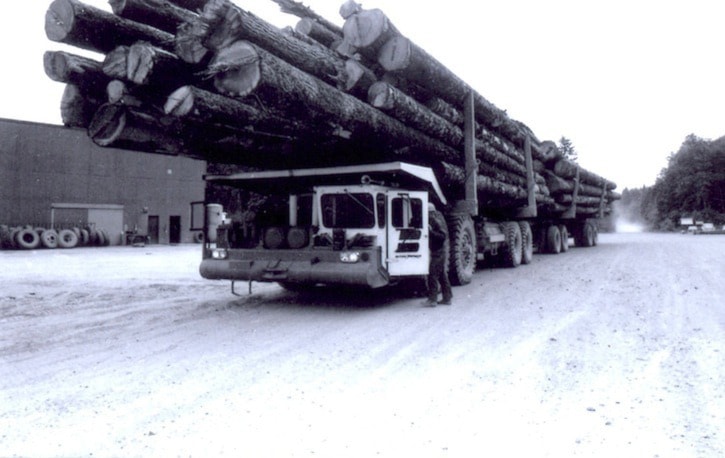Spectacular would be one word to describe the behemoth Butler Brothers Mark V log hauler, fully loaded with pup, shown here in the mid-1970s. Butler Brothers, who began their 29 years of logging in the Sooke/Otter area in 1946, gained a reputation for being innovative in their woods operations.
One example would be their efforts to design an off road truck that could carry a larger load than normally carried on a regular logging truck and trailer. Ingenuity was the name of the game, and when bush pilot Claude Butler began working with a fellow flyer Barney Oldfield in Saanich, the Butlers had a prototype ready by the early 1970s. It wasn’t possible for such a vehicle to use a public highway, so the truck was barged across Saanich Inlet, offloaded and brought to Sooke through the woods at Shawnigan Lake.
It turned out that the company built a series of these vehicles, as they learned by experience, how the vehicles would handle on the challenging hills and curves of the upper watersheds west of the Sooke River. By the time the Company had built their fourth, Mark V, shown here courtesy of Toby Hird, they had perfected a system that utilized a double-steering axle.
Woods foreman at the time was Ray Pimlott; Larry Jay did the loading in the woods, and Joe Zigay ran the hydraulic offloader that lifted the loads off the vehicle after its journey, often driven by Harry O’Neill, down Butler Main to the Company’s sea level sorting ground at Sooke Bay. Veteran loggers recall that the Mark V carried, between the truck and the pup, loads ranging from 150 to 200 tons. As each of these haulers became redundant, they were purchased either as operating vehicles or in parts, by trucking aficionados, who considered them priceless symbols of Vancouver Island history.
One such purchase was made by Toby Hird and his partner Dave Ferris who ran the Number 70, third in sequence, in their operations at Caycuse. A poster illustrating Number 70 (given us by Eric Butler) can be seen in the entrance gallery in the Sooke Region Museum. While the dismantled Mark V is in pieces today, some of them in Powell River, one often sees mention of the famous vehicle on international trucking websites.
Sooke’s Bruce Butler tells us that his dad Wally and his uncle Claude were twins and when born prematurely in Brentwood in 1911, they were initially kept warm through the oven heat of a woodstove, truly a pioneer beginning. The Mark V has been immortalized for Sooke through a scale model created by Fire Chief Steve Sorensen and presented as a gift to the Charters River Salmon Interpretive Centre.
Elida Peers,
Historian
Sooke Region Museum
